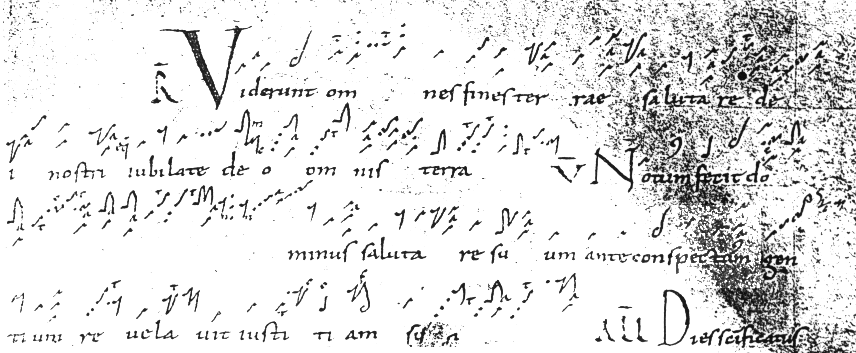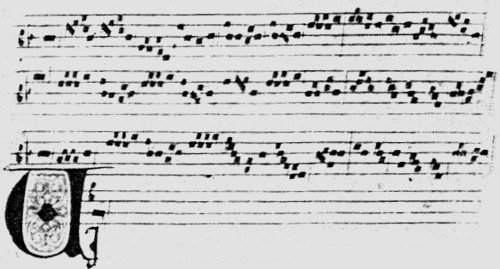
The Viderunt Chant in an early manuscript from Laon

 |
Anonymous IV may not be the most reliable source, his treatise dates from at least fifty years after the death of the men mentioned within; Perotin, himself, may never have existed: Anonymous IV is the only mention of the composer. Nonetheless because of their stylistic similrities we accept the works attributed to "Perotin" as coming from the hand of a single composer. In his account, Anonymous IV mentions that Perotin composed two four-voice organa: Viderunt and Sederunt. Viderunt is an gradual chant for the mass of Christmas Day (at Notre Dame, however, it was reserved for the Mass on January 1). Sederunt is from the gradual chant for St. Stephen's Day (Boxing Day: December 26). Graduals were sung after the epistle (the New Testament reading) and before the Alleluia, basically right before the reading from the Gospel - in this case, the traditional account of the birth of Jesus. Like Alleluias, Graduals were among the most florid and melismatic chants. We can date Perotin's setting based on an edict written by Bishop Odo of Sully - the man in charge of Notre Dame. In the edict, Bishop Odo seeks to put an end to the Feast of Fools, a yearly celebration when the church's rules were stood on their head: asses were led into the pulpit and sausages were consumed on the altar, aong other pernicious acts. In place of the Feast of Fools, the church created the Feast of the Circumcision for January 1. Bishop Odo writes: "The Gradual [Viderunt omnes] and Alleluia will be sung in two-voice, three-voice, or four-voice organum in silk copes." Thus it seems likely that Perotin's Viderunt was written for the Feast of the Circumcision in 1198 and his Sederunt in 1199. This luxuriant music would have filled the cathedral during the holiday season. |


| Vi- | 0:00 | Group of soloists establish mode and consonant intervals. Central pitch, then octave, then fifth. |
| i - | 0:13 | Soloists begin 4-voice organum. First note of chant held as a long drone. |
| de - | 0:59 | Second note of chant is elaborated, organum continues. |
| -runt | 1:29 | Third note of chant is elaborated. |
| Om- | 2:31 | The fourth note of the chant is elaborated. |
| -nes | 3:42 | Cadence |
| finis terrae salutare Dei nostri Jubilate Deo omnes terra. |
3:47 | Chant is sung monophonically |
| No- | 4:55 | Return to polyphony. |
| -tum | 5:54 | a new held note. |
| fe- | 6:18 | The next note in the chant. |
| -cit | 7:10 | Cadence with extension continuing as before. |
| Dom- | 7:43 | More active with motion of the held voice as well. |
| -i - nus sal- | 8:13 | quick through "i" a sort-of closure and continuation at a higher pitch for "sal" - the first "ah" in the composition. |
| lu-ta | 8:40 | Ecstatic return to "ah." |
| -re su | 9:08 | Closure and continuation on "su" |
| um: an- | 9:28 | Long closure again return to "ah" |
| -te consectum gentium | 10:00 | quick closure and then faster movement through next few notes of chant. |
| re-ve-la-vit | 10:45 | Faster harmonic motion. |
| justitiam suam. | 11:08 | Return to monophony: unison chant. |
|
Viderunt omnes fines terrae salutare Dei nostri: Jubilate Deo omnes terra. Notum fecit dominus salutare suum: ante consectum gentium revelavit justitiam suam. |
All the ends of the earth have seen the salvation of our God: Sing joyfully to God, all the earth. The Lord has made known his salvation. In the sight of the nations He has revealed His righteousness. |